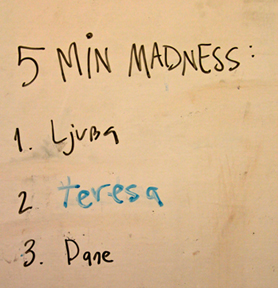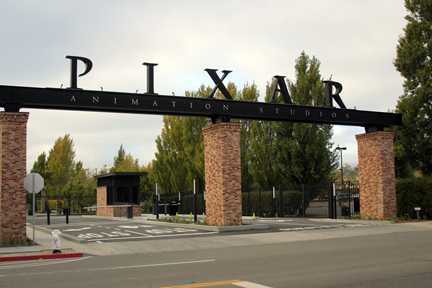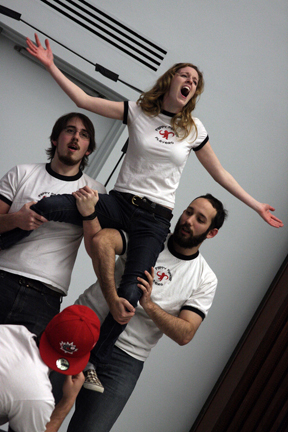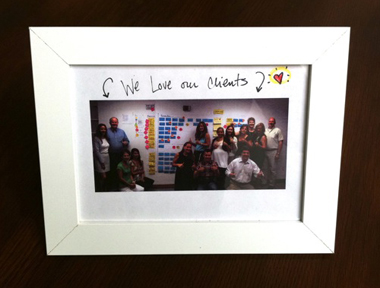What is an environment? Surprisingly, that seemingly simple question can be very difficult to answer, because environments are complicated. They are made up of all kinds of variables, physical and intangible, that affect how we feel, how we act, and what we do.
Winston Churchill once said, “We shape our buildings, and afterwards our buildings shape us.” Physical spaces do indeed elicit certain behaviors, but there is another invisible but powerful component at play in our environments: conditions. Elements such as social dynamics, communication styles, and creative inspiration deeply affect our experience of work and what we create. While most of us don’t have the authority to change the architecture of our work places, we do have the power to affect the conditions we work within.
We Can Create This Shift Through Intentional Environments
An intentional environment is a philosophy about how to approach the design process. Very simply, it is setting up the conditions that foster great work. While that approach may seem obvious, we don’t always act upon it. In my experience as a consultant for a wide variety of clients and industries, I’ve noticed a tendency to focus more upon the design work and deliverables than the environment that gives birth to the work. This ill-balanced focus is understandable; a lot of money is on the table, stakes are high, and there is never, ever enough time. But environments and design are symbiotic. No matter how brilliant your designs, they will die in a toxic environment; either they’ll halt completely, or they won’t evolve as richly as they could. If you want to increase your odds of success, you’ll invest the time to craft an environment that empowers.
Ed Catmull, Pixar’s president, attributes Pixar’s success to such an environment. He says you can’t force talented people to work well together, but as he says in Harvard Business Review Article titled How Pixar Fosters Collective Creativity:
What we can do is construct an environment that nurtures trusting and respectful relationships and unleashes everyone’s creativity. If we get that right, the result is a vibrant community where talented people are loyal to one another and their collective work, and everyone feels that they are part of something extraordinary.
So how do you and I create environments like this?
Designing an Intentional Environment
An intentional environment begins with four steps:
1. Choose intentionality
It may sound trite, but an intentional environment can’t begin without the intent. You must have the fundamental belief that environment has impact, and choose to allocate time and energy to crafting it. Environment has to be a priority. Sharing and discussing this shift in focus with your team or company will make the intent more powerful and likely to succeed.
2. Take action
Intent is meaningless without action. Begin crafting your intentional environment by writing down and sharing principles (statements of belief) that will define the environment. Your principles should be in service to team dynamics that foster great work. For example, one of Pixar’s principles is that “it must be safe for everyone to offer ideas.” [*]
3. Activate the environment for others
This step is the most critical. Once your principles are in place, craft practices that will support them. These practices must include others, so that everyone becomes involved in and responsible for making the environment come alive. One of Pixar’s practices is to show incomplete work to the whole animation crew for feedback. While the director ultimately chooses the direction of the work, he or she takes everyone’s perspective into consideration. This practice fosters an environment of healthy critique, which leads to higher quality work. [*]
4. Repeat for every project
Every time you work with a new group of people to make something, you should craft a new environment that reflects the unique dynamics of the situation. This means the principles and practices of the environment should change to best suit the personalities, skills, organizational culture, and project needs at that time. This practice of hitting the reset button has the added benefit of allowing previous players to show up differently on each project and participate in new ways, which ultimately allows them opportunity for further growth.
Most importantly, ongoing attention to environments shows care and respect for the people working within them. People thrive in environments that nurture, and good relationships are fundamental to resolving conflict and developing trust within teams. Every project will have rough spots; resolving them in healthy ways is key to keeping work moving forward successfully. In my experience, the projects with the most inspired work and successful launches in the world are born out of environments that are conducive to trust and respect.
Examples and Inspirations from the Real World
Improv
Principle: Build upon ideas
Practice: “Yes, and…”
In improv, no matter what idea someone comes up with, your job as a responsible participant is to embrace and add to that idea. So, if I say, “Hey, will you take my rabid porcupine to dinner?” you might say, “Yes, does she like chicken or beef?” This “Yes, and…” practice creates an environment of unrestrained ideas because it supports risk-taking, builds trust, and forces everyone in the scene to stay in the moment. “No”, on the other hand, shuts down ideas. Imagine if, in the concepting phase of your next project, you hosted a “Yes, and…” session. Each team member would bring an idea, then swap, then build upon the idea they ended up with.
Adaptive Path

Practice: 5 minute madness
We start our monthly company meeting at Adaptive Path with a practice called “Five Minute Madness.” Anyone can sign up for a five minute slot, and they must throw out a statement that they aren’t sure they believe, want some feedback on, or intend for debate. Recently someone stated, “We are losing our culture as we grow.” This practice created a space for conflicting perspectives and allowed for a tough conversation that isn’t typically invited within organizations. While intentional environments won’t solve all your problems, they can give you the tools for dealing with conflict constructively. What principle could you put in place to help your team through tough moments?
Rail Europe (Remote Teams)
Principle: One big team
Practice: Find ways to celebrate our clients
When working on a project for Rail Europe my colleague Kate Rutter and I made a point to build a co-creative relationship with the client team. We did this, in part, by finding lots of small ways to celebrate and empower our relationship. For example:
Kate put this framed photo in our project room to communicate an intention she had for herself and wanted to activate for us. This act wasn’t client-facing; it was a simple but powerful gesture she made for our internal team as a reminder.
- Because our two teams were not located in the same city, the Rail Europe team did not know what our offices looked like. Having a sense of each other’s “design home” can make working relationships more intimate and human, so I had our team create a fun, three-minute video tour of our space that we sent to Rail Europe as a surprise. Again, a small gesture, but it helped support our principle of “one big team.”
These acts collectively helped create an environment where the Rail Europe team was embraced as a full part of the design team and co-created the work with us. This shared ownership enabled Rail Europe to successfully execute upon and launch the designs. If our relationship hadn’t been so strong, the handoff of work between our team and theirs would not have ended as successfully.
Small gestures like these are examples of things anyone can do to activate an environment. No matter what your role within an organization or team, you have the power to impact the conditions your team is working within.
How Do You Begin?
Start your next intentional environment by answering two questions:
- What principle would you like to see flourish? For example, do you want to be open to new ideas?
- What practice can you put into place that will make that principle come alive for yourself and others? This should be something actionable in the present day, within your current constraints and resources. For example, if you want to be open to new ideas, you could have a team “Assumptions Dump” at the start of each project. Everyone would write assumptions they currently hold about the problem space or industry on post-its, post them, and discuss. This would give everyone a chance to reflect upon how they can be more open and help each other do the same.
Once you have a principle and a practice in mind, try them out. Declare your intent to your colleagues, or do it in stealth mode and just see what happens. Either way, you’ll discover that this approach will give you an opportunity to re-imagine what it means to be a part of a team, empower yourself and others, and create an environment where everyone cares more about the work.
Or, another way of putting it: instead of designing like you give a damn, you and your teams will actually give a damn, because you’ll be a lot more invested.
Leave me a note in the comments area below to let me know how it goes.




 Kate put this framed photo in our project room to communicate an intention she had for herself and wanted to activate for us. This act wasn’t client-facing; it was a simple but powerful gesture she made for our internal team as a reminder.
Kate put this framed photo in our project room to communicate an intention she had for herself and wanted to activate for us. This act wasn’t client-facing; it was a simple but powerful gesture she made for our internal team as a reminder.

